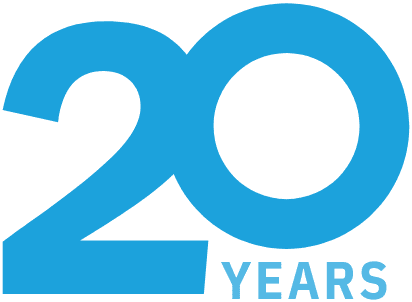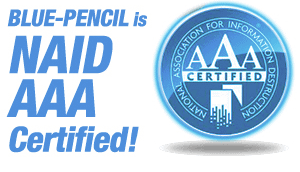The process of creating an effective records management system is rife with challenges like inefficiencies or lack of clarity and direction. Click here to see how we help organizations develop a tailored records management strategy. Chapter 2 of the Records Management Services guide offers insights into creating an effective system. The keys to an effective records management system are ensuring you have the right skill set, developing a classification scheme, defining a metadata model, ensuring records management is represented, leveraging staff for quality control, inviting regulatory input, and ensuring stakeholders are engaged. Read on for strategies and tips on addressing each problematic dimension.
“Very courteous staff who perform their duties in a timely, professional manner. We are very pleased with Blue-Pencil’s service and would highly recommend them in the future.”
-Shirmilla Maharaj
 When A Records Management System is Needed
When A Records Management System is Needed
Organizations face a number of challenges when creating a records management system. Overcoming these challenges or barriers can make the difference in unlocking competitive edge, operational efficiency, and regulatory compliance while also safeguarding stakeholder information.
Challenges:
- Need for balance of compliance and efficiency when managing records
- Limited awareness of when information should be archived or disposed
- Difficulty in searching for or relocating records
- Employees spend too much time looking for information
- Staff are unable to utilize existing knowledge or information
When a system is needed: Simply put, if there are no staff members on your team that are accountable for managing regulatory compliance and information security and availability needs, your organization needs a records management system. The safeguarding of records is the responsibility of all employees, but accountability should be assigned to specific individual(s) within your team. If you experience any of the challenges identified previously, this is a strong indicator that your organization may benefit from starting or improving its records management system.
Benefits of a Records Management System
Every organization manages information, and this process can be approached intentionally, increasing value, or haphazardly, leading to business impediments. Here are some reasons why your organization would benefit from having a records management system.
- Knowledge sharing and learning: An organization that positions itself to allow employees to learn from the past and position for the future is one that will better serve its stakeholders.
- Compliance with regulatory requirements for information management: Organizations in Ontario must adhere to PIPEDA, a regulatory act that specifies requirements for working with personal information. A records management system not only helps organizations meet regulatory requirements but also offers a clear demonstration of due diligence, reducing or avoiding fines and penalties.
- Business continuity planning: Without information flowing through the organization at the right place and the right time to the right people, business comes to a halt. Information management helps ensure that despite disasters or unexpected events, your organization can continue to function with the vital data required.
Keys to Records Management Systems
The lifecycle for an information asset may include record creation, access, classification, modification, archive, backup, and disposal. Every record within an organization will go through one or more of these stages. Each stage is managed by business policy and processes, human resources, technology systems, or any combination of these. The key to an effective records management system rests in unlocking the strengths of each area as well as integration to serve the needs of the organization and meet regulatory requirements.
- Develop or hire information management professionals: Without qualified and experienced professionals, information management will be limited in its impact on your organization. Having the right skill set and growing your team to become more adept at information management is a crucial focus area. With the information footprint of each organization expanding daily, it would be prudent to expand the expertise in managing the information. A trusted provider can also provide training and insights to your team, allowing them to marry business experiences with a technical information management skill set.
- Create a classification scheme: AIIM (Association for Information and Image Management) suggests that a classification scheme helps an organization share information in a form that people in the organization can understand and make it easier for staff to utilize. Having a classification scheme will bolster your organization’s ability to quickly search and retrieve information.
Develop a metadata model: Metadata is information about a subject that can help describe and classify information. On a computer, each file has information such as date created and file type that aids in searching the information. Likewise, a metadata model for various types of records can help your staff understand when it should be disposed of and who is authorized to view the information. The association suggests that a metadata model that can be leveraged across the organization can help ensure consistency and save time for new departments wishing to better manage information deposits.
Ensure records management representation: Having a records management representative at planning meetings can help ensure that your organization plans for information management rather than reacting to mismanagement. Allowing a voice for records management allows your organization to plan to make use of information.
- Leverage broad staff quality control: Platforms like Wikipedia and community forums have provided ways for countless users to take part in information management and knowledge sharing. We spoke earlier about how records management is everyone’s responsibility. Using tools like Confluence, Jive, or Socialtext will help your team collaborate and improve the quality of your information. The continuous cycle of improving the quality of records and increasing staff participation is accelerated through the clear articulation of the benefits of accessing content that can help everyone do their jobs better.
Invite regulator input: Often when companies are tagged with a penalty for non-compliance, this is their first encounter with the privacy arm of government. Inviting regulators to be part of the process of planning and initiating a records management system can help build relationships and ensure your company meets compliance requirements. The Office of the Privacy Commissioner of Canada is available here to help answer questions or to provide input. Don’t wait till an issue arises. Demonstrate due diligence from the get-go.
- Create buy-in by engaging stakeholders and invite on-going feedback: Without the wide support of your organization’s staff, it is difficult to create a records management system that serves the needs of your team. Ensure that they are given ample opportunity to be educated and made aware of the challenges that are being addressed and how these issues can also make their work more efficient and effective. Invite on-going feedback to keep in touch with changing needs and to bolster their continued participation in helping ensure records security and availability needs are met.
Blue-Pencil Helps Organizations Synergize Policy, Process, People, and Technology with Records Management to Deliver Value
Without a proven advisor, even the best strategies and technologies can remain disparate systems and organizations may remain at risk or suffer declining productivity. Typically implementing key records management best practices can take 6 months to a year while only seeing modest improvements in organizational efficiency or information security. Our team focuses on helping companies ensure secure and effective records management across industries like government, healthcare, manufacturing, and small business. Let us help you quickly and effective harness the potential of a records management system.
Expert advisor in strategic information management and proven hands-on experience
Ability to deliver compliance while managing organizational efficiency
Proven systems and methodology for managing information retention schedules
Training, resources, and support for your staff to become adept at information management
High standards in information destruction services with NAID AAA and Privacy+ certification
Sources:
http://info.aiim.org/how-to-achieve-best-practices-for-records-management
Records Management Services Guide


 When A Records Management System is Needed
When A Records Management System is Needed

 Develop a metadata model: Metadata is information about a subject that can help describe and classify information. On a computer, each file has information such as date created and file type that aids in searching the information. Likewise, a metadata model for various types of records can help your staff understand when it should be disposed of and who is authorized to view the information. The
Develop a metadata model: Metadata is information about a subject that can help describe and classify information. On a computer, each file has information such as date created and file type that aids in searching the information. Likewise, a metadata model for various types of records can help your staff understand when it should be disposed of and who is authorized to view the information. The  Ensure records management representation: Having a records management representative at planning meetings can help ensure that your organization plans for information management rather than reacting to mismanagement. Allowing a voice for records management allows your organization to plan to make use of information.
Ensure records management representation: Having a records management representative at planning meetings can help ensure that your organization plans for information management rather than reacting to mismanagement. Allowing a voice for records management allows your organization to plan to make use of information. Invite regulator input: Often when companies are tagged with a penalty for non-compliance, this is their first encounter with the privacy arm of government. Inviting regulators to be part of the process of planning and initiating a records management system can help build relationships and ensure your company meets compliance requirements. The Office of the Privacy Commissioner of Canada is available
Invite regulator input: Often when companies are tagged with a penalty for non-compliance, this is their first encounter with the privacy arm of government. Inviting regulators to be part of the process of planning and initiating a records management system can help build relationships and ensure your company meets compliance requirements. The Office of the Privacy Commissioner of Canada is available 